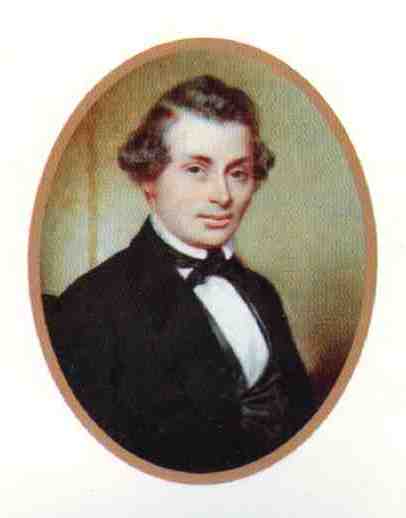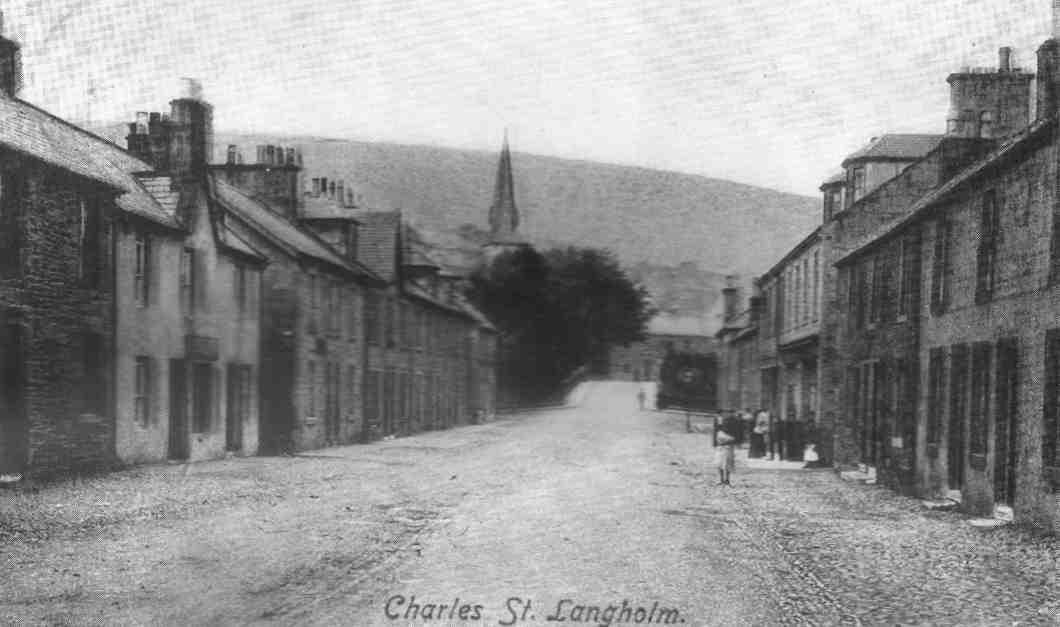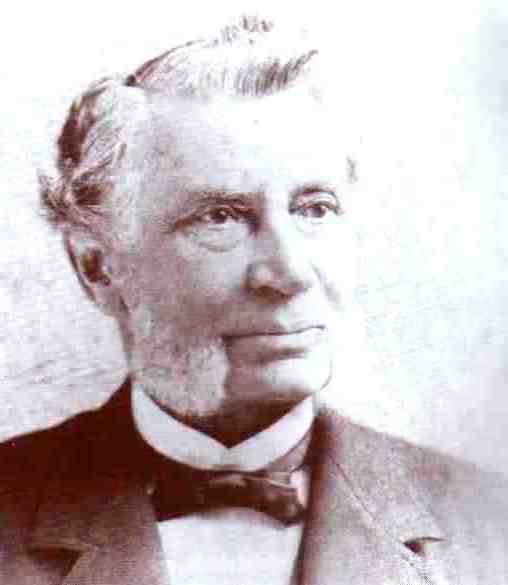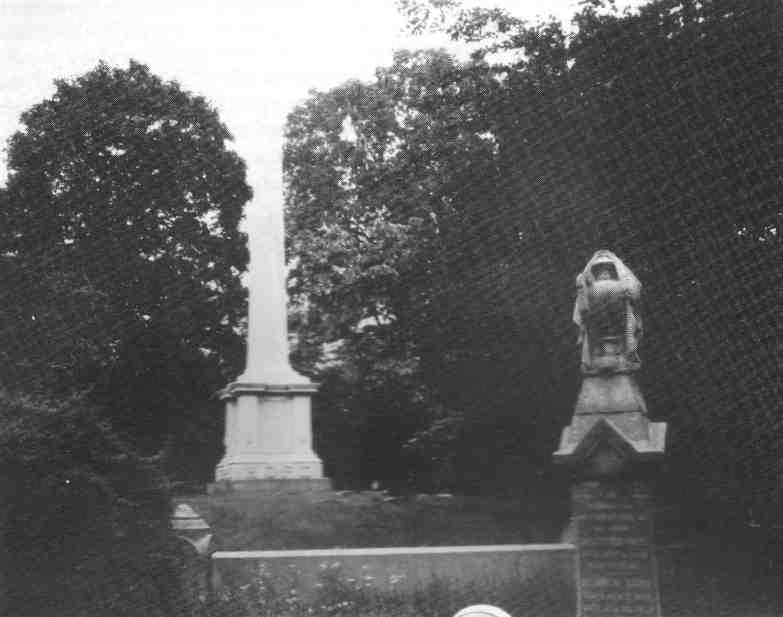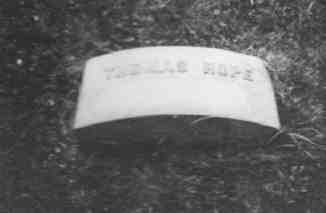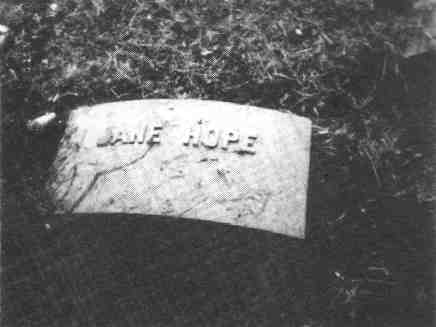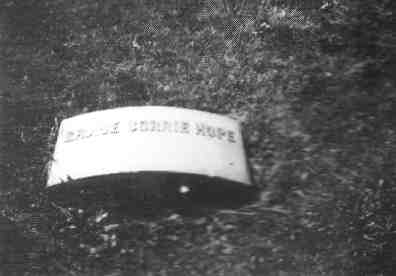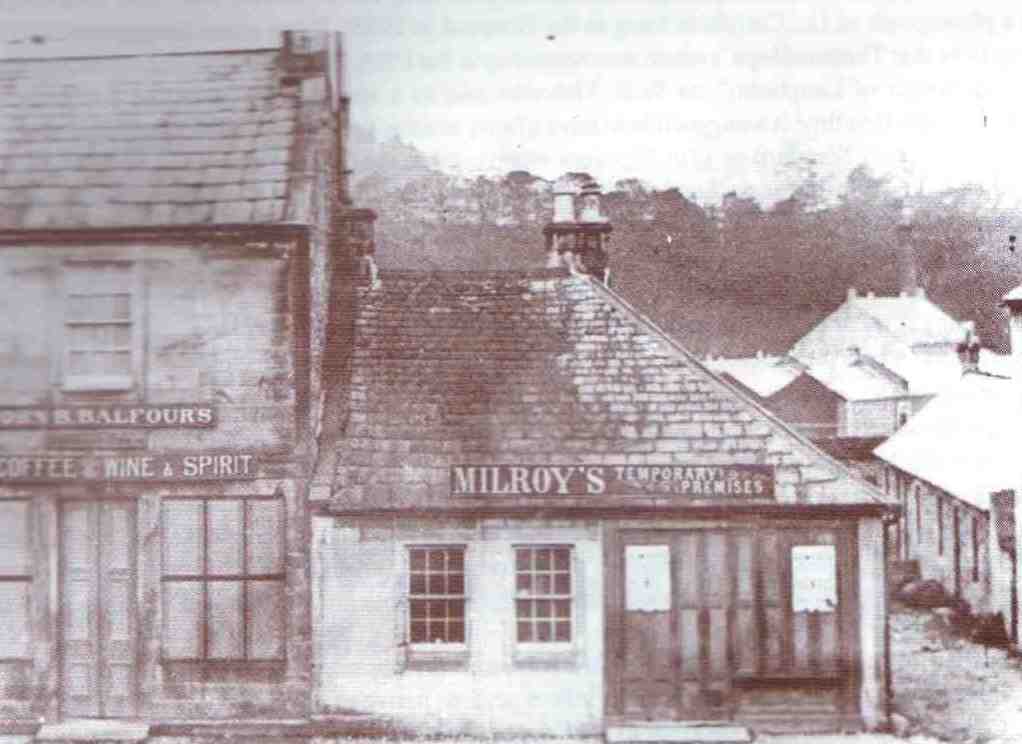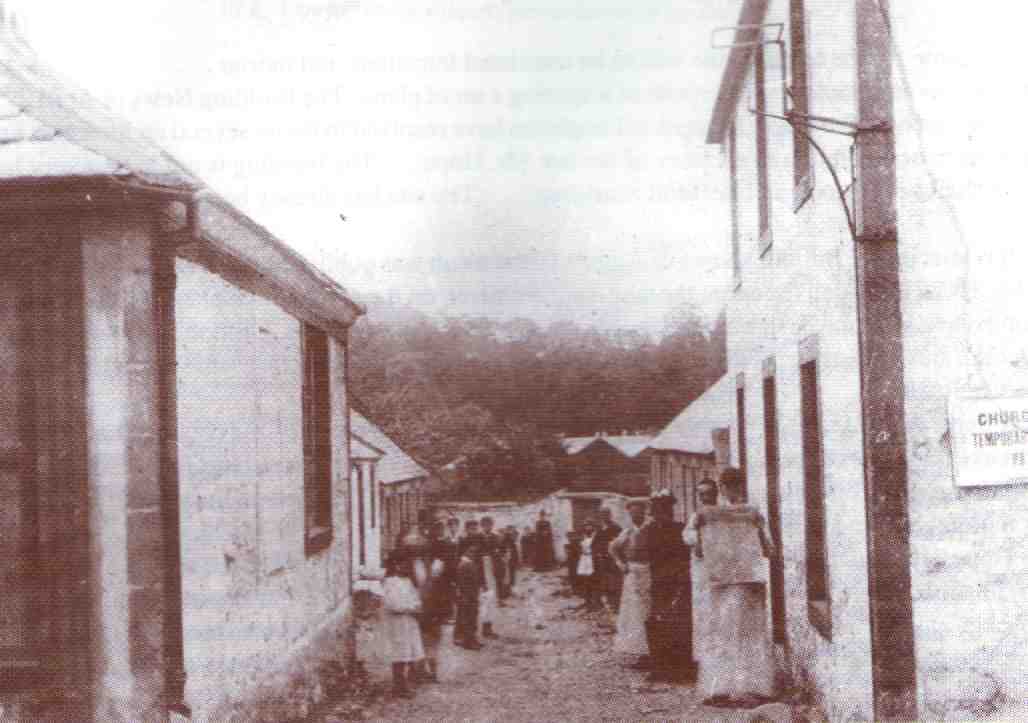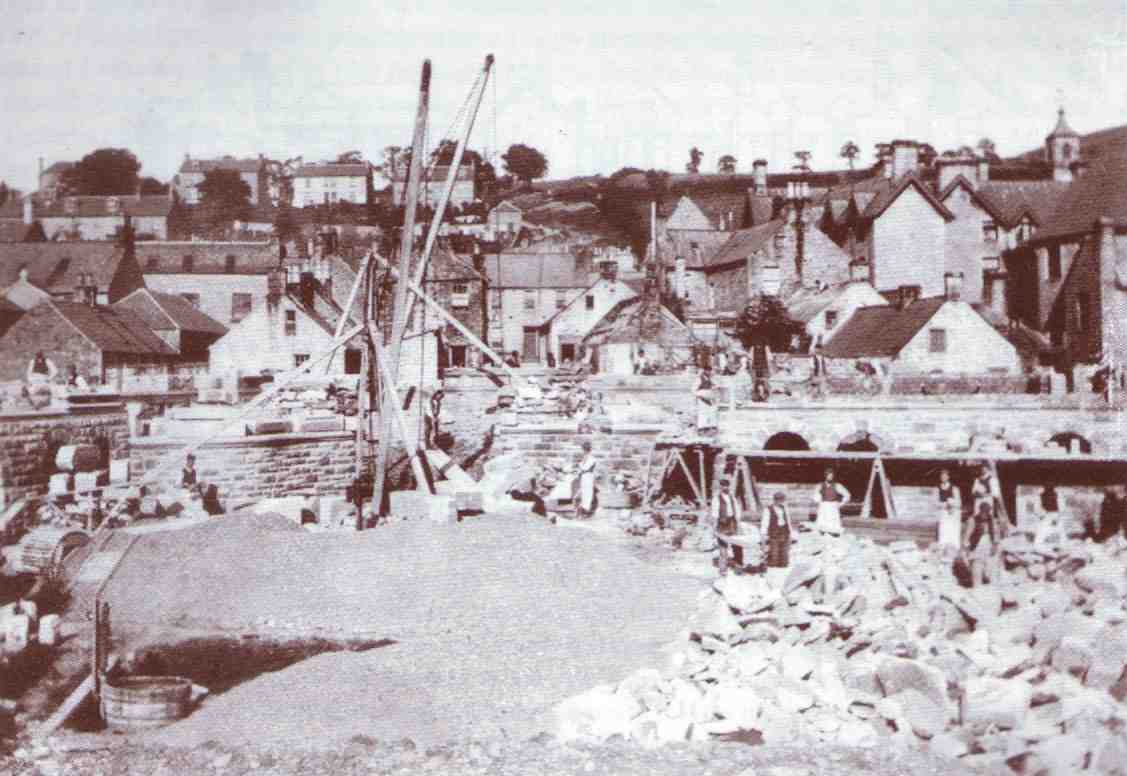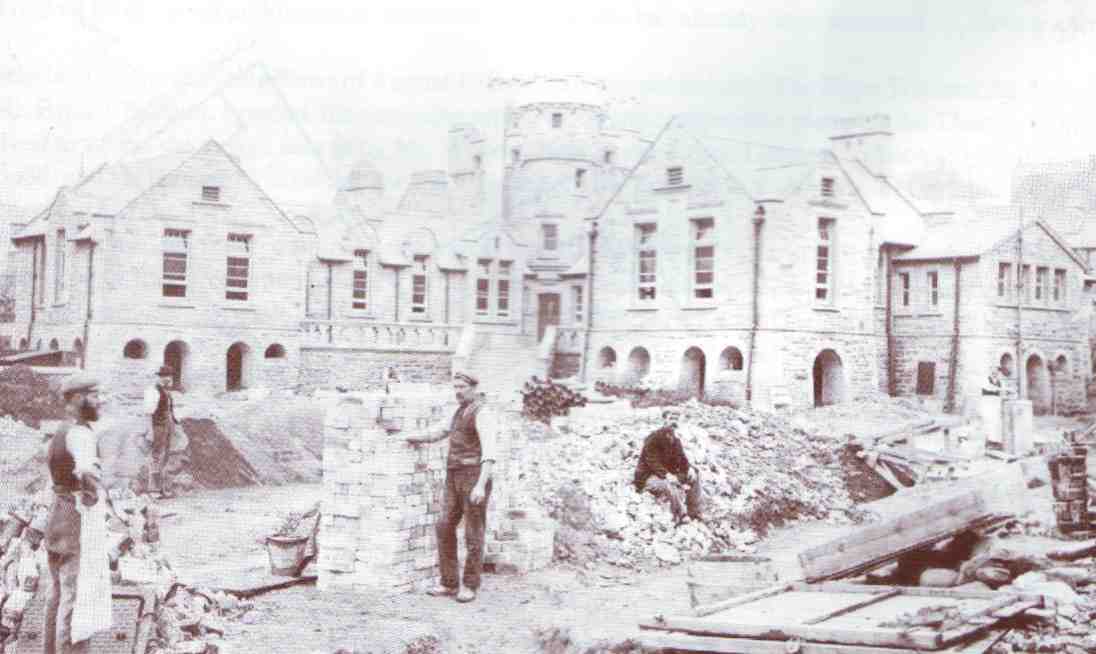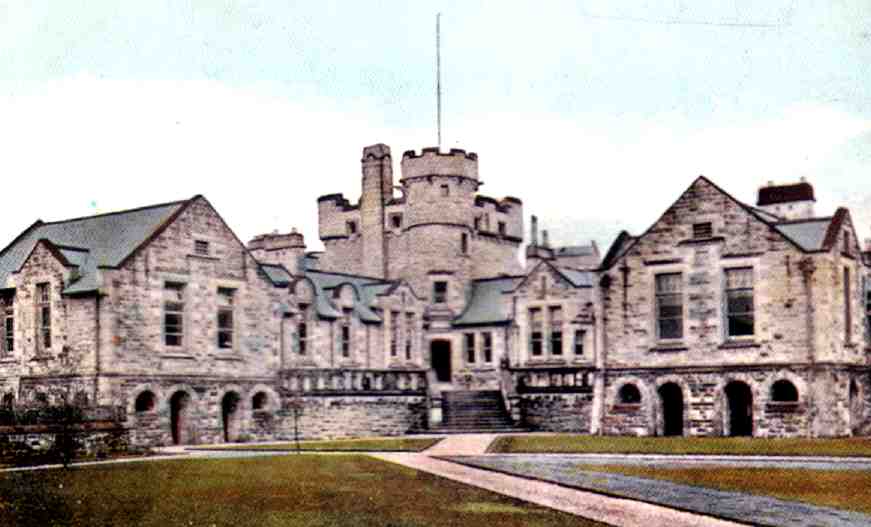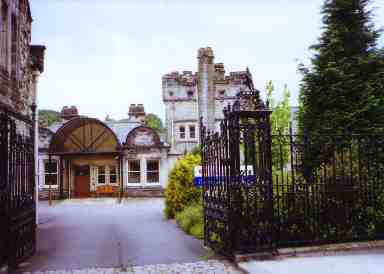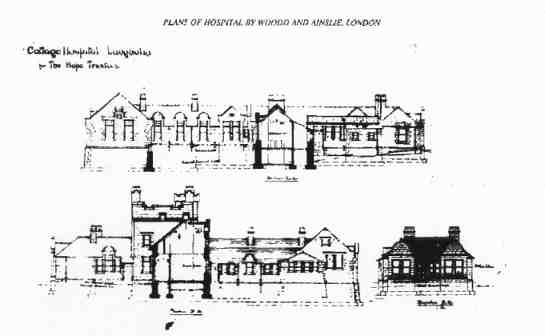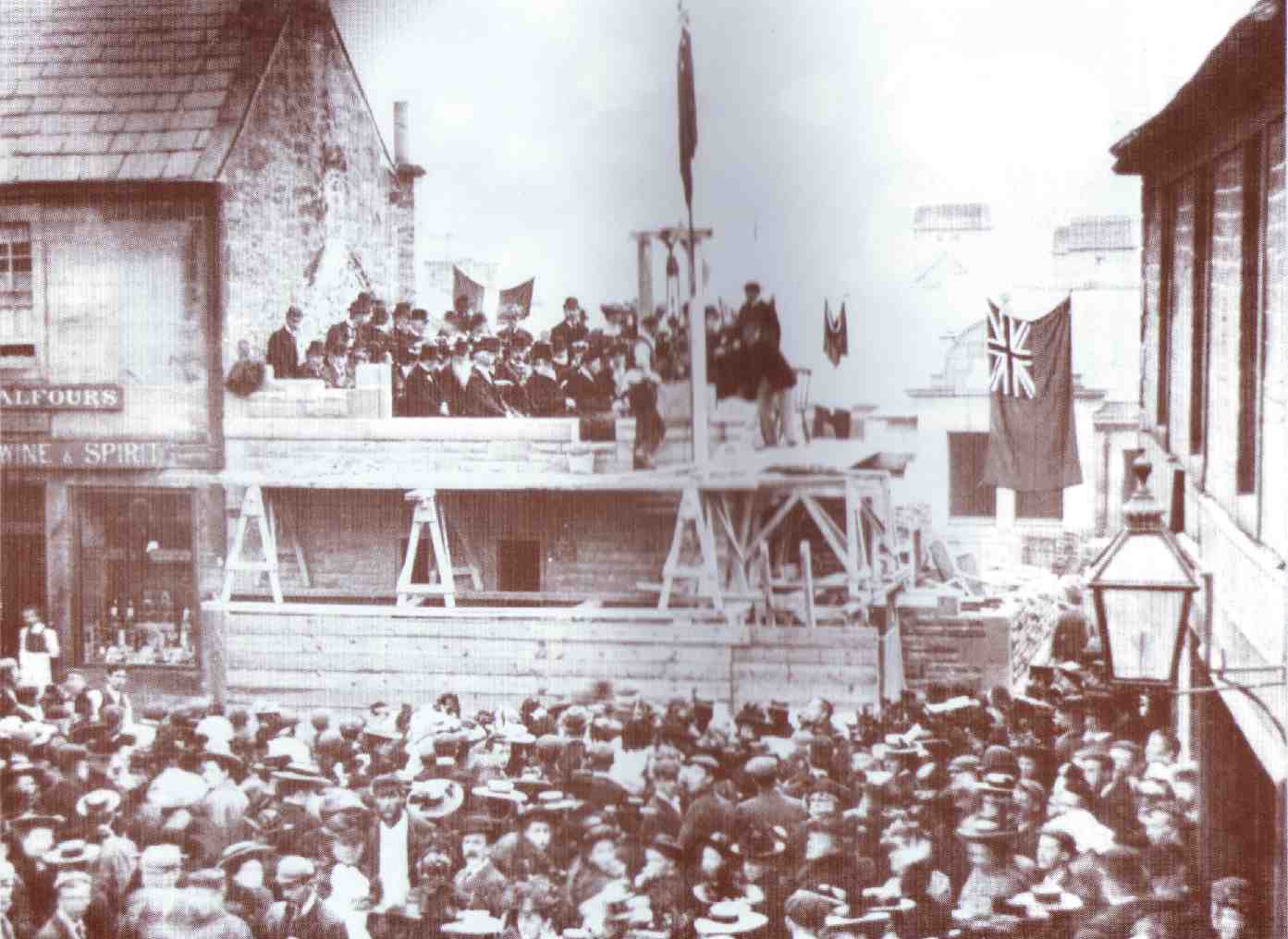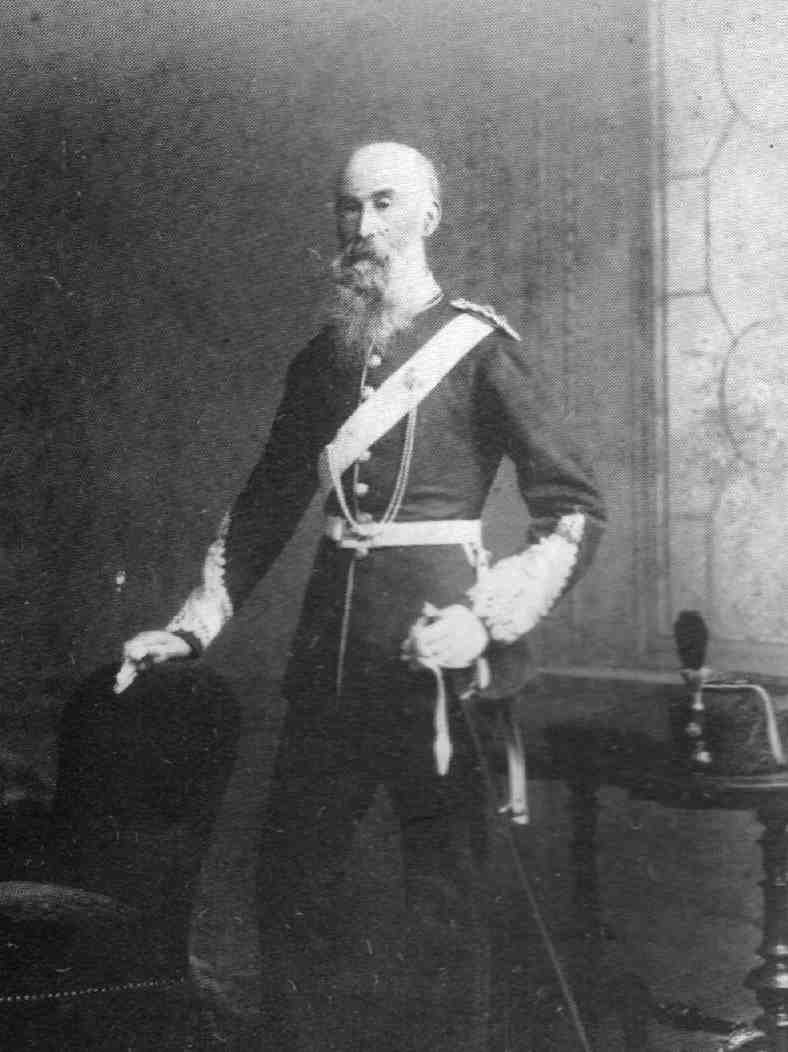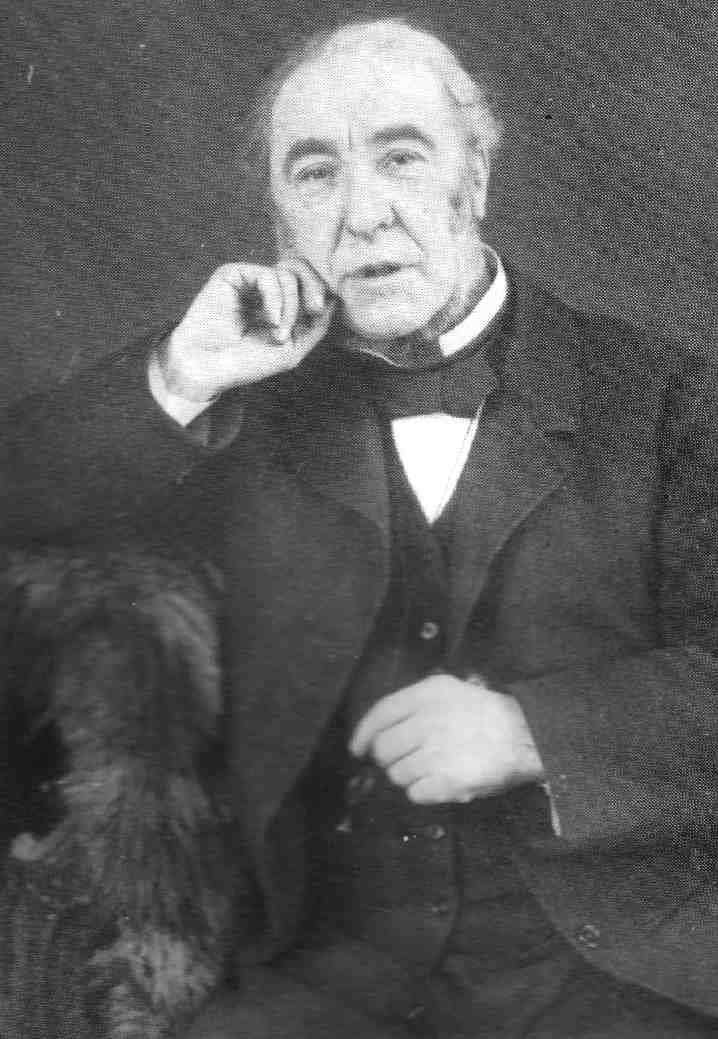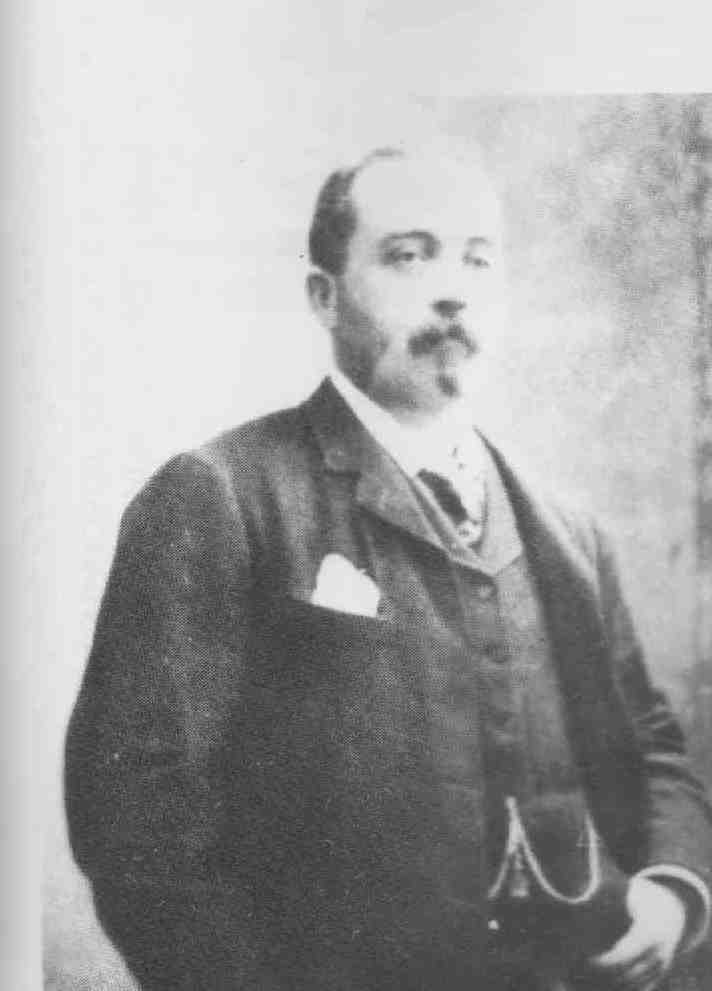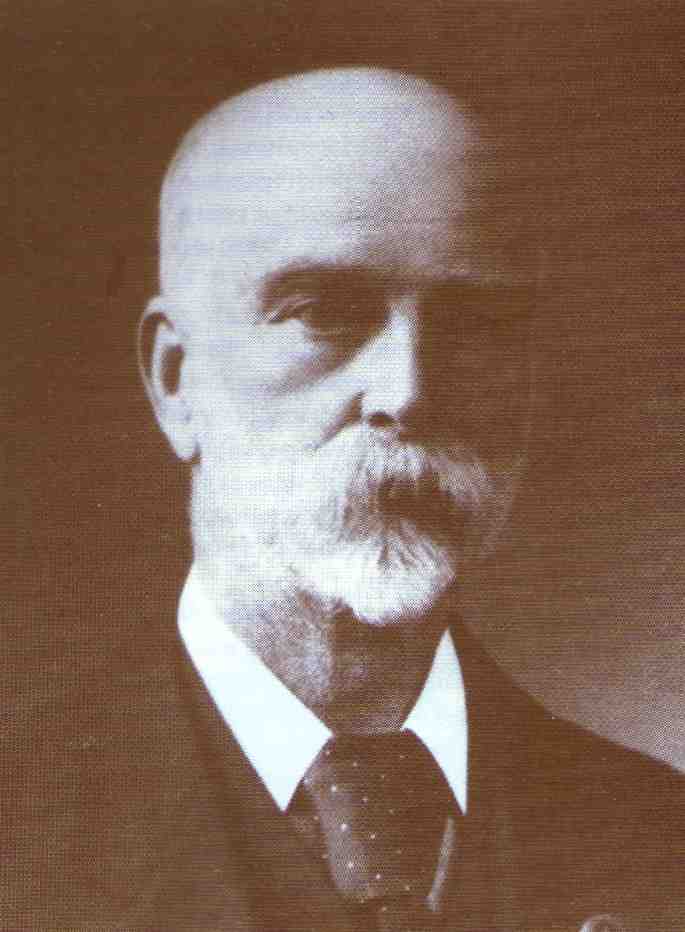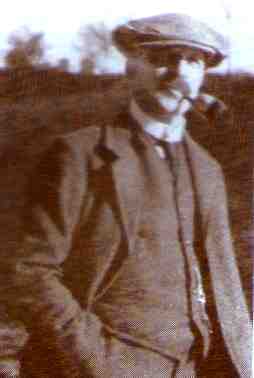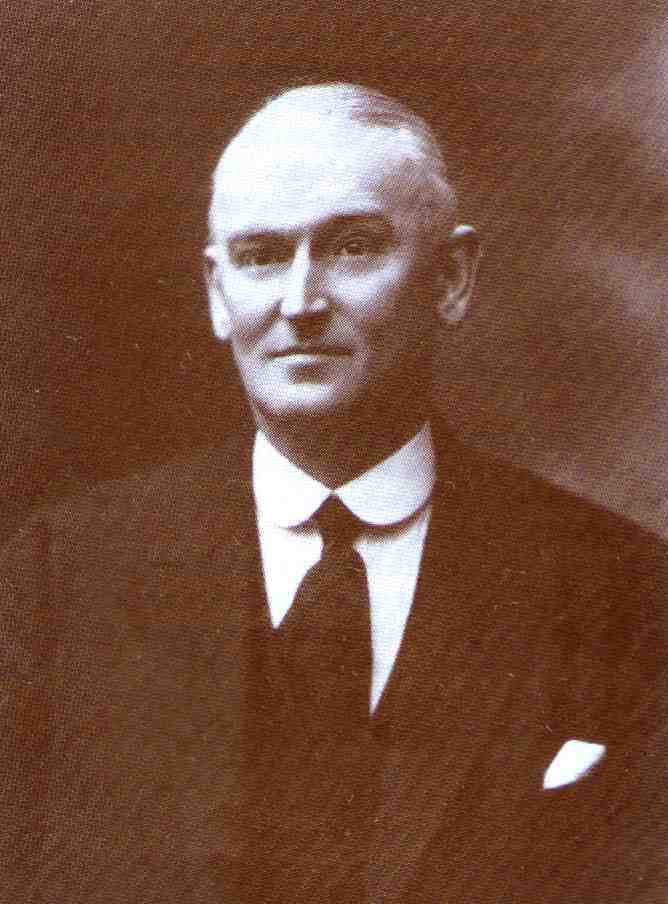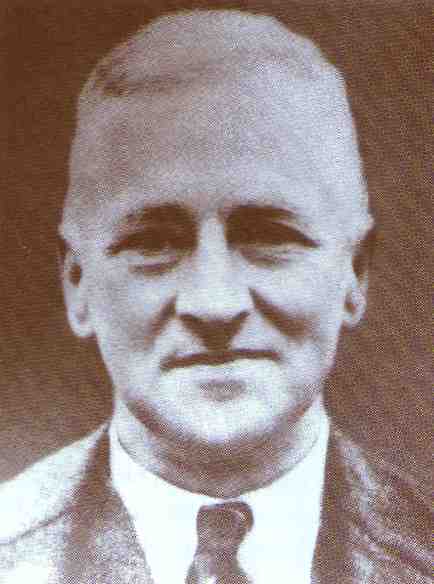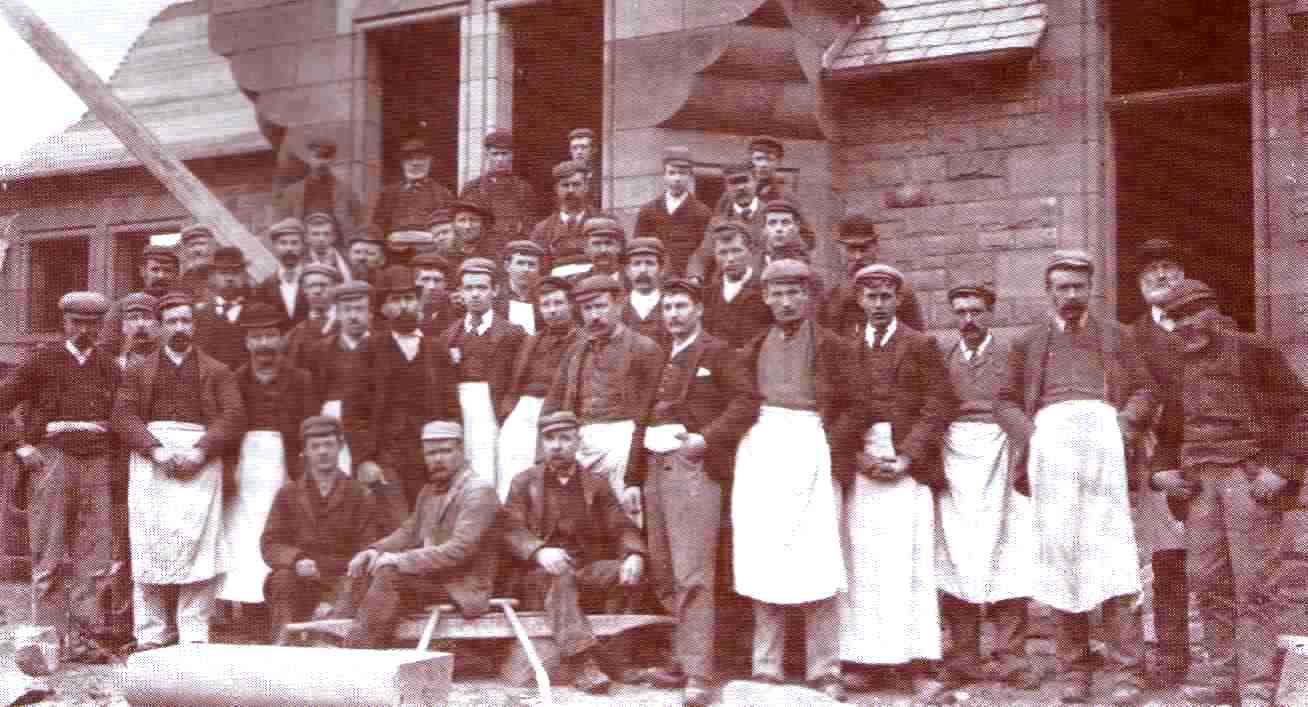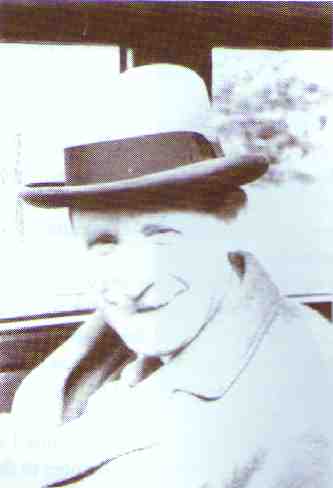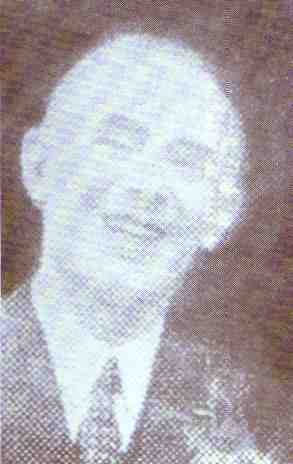I have simply transferred the text of History of THOMAS HOPE HOSPITAL booklet which was printed and issued to the public in 1989 into HTML format so as to be legible on the Internet.
The Hospital is unique and has been central to the progress of Langholm
Frank Zemla - May 2001
ACKNOWLEDGEMENTS
Publication of the 'History of Thomas Hope Hospital' has been made possible because Dumfries & Galloway Health Board released the necessary funding from Health Board Endowments. The support of Health Board personnel has been vital to the research project: In this context I mention Mr. J. McIntyre, Chairman; Mr. Michael Cook, General Manager; and Mr. Michael Gault, Unit General Manager of Acute, Maternity and Long Stay Hospital Services, which include Thomas Hope Hospital. However, it was Mrs. Anna May Ferguson, the Hospital's Clinical Nurse Manager, who put forward the initial request for consideration to be given to the question of publishing at this moment in time...
It has been a most rewarding and enjoyable experience for me to have the opportunity of becoming better acquainted with Langholm and its people, in the course of researching the history of Thomas Hope Hospital, an exercise into which so many local people have entered very wholeheartedly.
My first point of contact in 1985 was a telephone call to Mrs. Elizabeth Bell, the then Nursing Officer. She directed me to Mr. Robert Weatherstone, Secretary of the Hope Trust, and through him to the late Mr. Alex. Scott, Chairman. I am very grateful to them for sparing the time to talk to me and for permitting me to have access to Trust records pre - 1948. Had I been denied this privilege, an authoritative history could not have been written.
Mr. Weatherstone very kindly arranged for me to read the Minutes, etc., in the Town Hall, where I was given the honour of using the room in which the Hope family memorabilia are lodged. It was there that I met Grace Brown, who was an amazing source of information; her colleague, Eleanor Cowan, also with useful local knowledge; and the late Eddie Armstrong M.B.E., a man recognised to be omniscient on the subject of Langholm.
I was advised to proceed to the other side of the Town Hall to the (Telford) reference library, where Mr. George Irving presides. He, too, was a mine of local information - as indeed were his 'cronies'. Here I was treated to the very essence of Langholm in terms of accent, conversation and personality, as they discussed past glories and as I, attention divided, scanned the volumes of the 'Eskdale and Liddesdale Advertiser', aided by Mr. Irving's personal Index.
Through George Irving I met Mr. William Tait. I could not have had two more knowledgeable accomplices in my quest, especially for old photographs, since they are both keen collectors. Mr. Tait has been most assiduous in pursuit of material on my behalf. There was many a time when I, in Dumfries, needed a willing aide on the scene: I knew I could rely on Mr. Tait on such occasions.
I had already built up a considerable volume of material before I visited the Hospital. I was unprepared for the surprise that awaited me. The building is tolerably impressive from the rear, the side most commonly seen; but when I first beheld the sturdy splendour of its frontal aspect, my admiration for this architectural gem was boundless.
Furthermore, that day I found myself in the company of an old friend, recently come to the Thomas Hope Hospital as Nursing Officer. Mrs. Anna May Ferguson and her staff have given every co-operation throughout my researches. In addition, I can't resist mentioning that the food and baking on offer in the Hospital equals the very best home fare.
Health Centre staff, especially Dr. Anderson, Dr. Kennedy, and Dr. Tinker, have afforded me every assistance throughout the project.
I consider myself privileged to have been welcomed to the homes of Mrs. Clark, Dr. Watt, Mr. and Mrs. Graham, Mrs. Bell and Miss Mann, where in the course of interesting discussion the pieces of the story came together. Their testimony was invaluable because only the barebones of developments are recorded in Health Board Minutes: They filled in the details.
At Mrs. Ferguson's persuasion, Mr. Norman Allan gave his time and professional skills to the task of photographing the present staff at the Hospital at several sessions. I also appreciate the kind co-operation of Ann Deery, Secretary of the Greenwood Cemetery New York for responding to my appeal for photographs of the Hope memorial. Mrs. E. Anderson, Miss Elton, Mrs. Kellie (nee Palmer Douglas), Mr. T. Beattie, Mr. Arthur Bell, and Mr. McCartney supplied some very useful pictorial material. My husband, John, also helped out on the photographic front.
The staff of Ewart Library Dumfries have, as always, been most helpful, especially Mrs. S. Wise and Mr. A. Cowper.
Miss Hazel Anderson of the Health Board Primary Care Staff was most attentive to my requests for information regarding G.P. practices and the Health Centre.
Finally I wish to express a debt of gratitude to the proof readers for their forbearance and sound advice: Dr. Anderson, Mrs. Bell, Miss Brown, Mrs Clark, Sister Connell, Mrs. Cowan, Mr. G. Crosbie (Health Board, Dumfries), Mrs. Graham, Mr. J. Glover and Mr. N. Hogg (Health Board, Dumfries), Miss Mann, Mr Gault, Dr. Kennedy, Mr. Irving, Mrs. S. Macfarlane (ex-Crichton Royal staff member), Mr. Tait, Dr. Tinker, Dr. Watt, Mr. Weatherstone, and above all to Mrs. Ferguson who willingly undertook the commitment several times.
Morag Williams
Health Board Archives,
Crichton Royal Hospital,
Dumfries
August 1989.
Langholm must have been buzzing with expectation one day in June 1888. The Eskdale and Liddesdale Advertiser of 20th June announced with barely suppressed excitement:
"It is, we learn, a settled fact that Langholm is to be the recipient of a munificent gift from a gentleman who will shortly arrive here from the United States..."
The gentleman in question was Thomas Hope, Langholm's model for Andrew Carnegie, whom he preceded by almost half a century.
His scarcely credible rags-to-riches story began on 3rd March 1809 at a house in Charles Street (New), now known as Thomas Telford Road. (Research extending to Langholm Parish records in Edinburgh has failed to uncover the exact location of the house. The late Eddie Armstrong, former Town Clerk, thought it was likely to be one of the houses towards the bridge end of the street.)
| Charles Street, now Thomas Telford Road, Langholm |
"Langholm As It Was" by Hyslop records details of his parentage: "His father, Matthew Hope, had had a cotton mill with a field attached, but was not successful in business. His mother was Grace Corrie of Corrie Common, near Lockerbie. Thomas was named after his uncle, Thomas Hope, a one time farmer in Bomby. In 1817 the father and his son, James, emigrated to New York, and two years later the mother and the rest of the children, including Thomas, joined them, the voyage occupying no less than nine weeks."
'Owing to the straitened circumstances of the family, they had to leave Langholm without paying school fees. Many years afterwards when Thomas Hope returned, a rich man, to his native town, he at once sought out his old schoolmaster and more than repaid him.'
In reading these scant biographical details one does suspect that the shame of the circumstances surrounding his departure from Langholm could have provided the motivation for Thomas Hope's outstanding success in amassing a fortune: in making a generous bequest to the town he was able to restore the family's good name. It must be said, though, that the press at the time read it as a demonstration of his affection for his birth-place.
Thomas Hope and one of his brothers set up a small grocery business in New York, thereby laying the foundation of a prosperous business empire. At the early age of 49 years, that is in 1858, Thomas and his brother were able to hand over three stores in Chambers Street, New York, and some 30 branches of their grocery chain to their clerks, who in return presented the brothers with the magnificent testimonial, now lodged with other Hope memorabilia in Langholm Town Hall.
Thomas Hope visits Langholm in 1888
Thomas Hope's arrival for a visit, which was to be of three months' duration to Langholm, is described in the Eskdale & Liddesdale Advertiser newspaper, dated 27th June 1888, thus. He "arrived in Langholm on Monday night, having landed at Liverpool from the S.S. Servia on Sunday. Mr. Thomas Hope, New York...is accompanied by his sister, Miss Hope; his niece, Miss Bell Hope; and his physician...the party have taken up their residence in the Eskdale Temperance Hotel." How it must have thrilled people to catch a glimpse of these important visitors! Here in the flesh was the local-boy-made-good from whom, it had been publicised, blessings would come...
The authors of 'Langholm As It Was' claim that Thomas Hope had made three return visits to Langholm, firstly in 1844; then a few years later; and finally in 1888. The Eskdale & Liddesdale Advertiser of March 12 1890 claims, on the other hand, that he visited only once before 1888.
The purpose of the visit in 1888 was described in the Eskdale & Liddesdale Advertiser of March 12 1890: "His visit to Langholm two years ago was mainly to arrange for the disposal of the residue of his estate, which was to be devoted to the erection and maintenance of a home in Langholm for the aged and infirm natives of the district, to be called the Thomas Hope Hospital. With this in view he purchased the freehold property in Irving's Close, with the houses erected thereon and the gardens adjoining and the Old Town Bowling Green.".;
As to the man himself: "Though well advanced in years his mental faculties were in no way dimmed, and he took a keen and lively interest in men and things around him which were intimately connected with this place or places he had known in his youth."
Thomas Hope
Founder
1809 - 1890 |
Thomas Hope was presented with an illuminated address prior to his departure for the last time: this framed text now hangs in a room at the Town Hall. Thereby an assemblage of the town's dignitaries on 16th October 1888 resolved:
|
"That Mr. Thomas Hope of New York, now on a visit to Langholm, his native town, having made known that he has under his Will made certain provisions for the care and relief of sick and infirm poor persons being natives or resident in Langholm and neighbourhood, and that he has acquired an eligible site for the erection of a public institution to be used in furtherance of that purpose, this meeting deems it most fitting that a deputation be appointed to wait on Mr. Hope, previous to his early return to America, and convey to him the sense of pleasure and gratification with which the gentlemen present regard Mr. Hope's great interest in the place of his birth, and the generous goodwill, which he bears to the inhabitants as shown in the splendid benefaction thus made known..." |
The signatories were:
Robert McGeorge, Acting Chief Magistrate
James Burnet, Chairman of the School Board
John Hyslop, Chairman of the Parochial Board
Rev. James Buchanan, Minister of the Parish of Langholm
Rev. James Panton, Free Church Minister
William J. Carlyle M.D.
John Scott, Manufacturer
Alexander Scott, Manufacturer
Walter Scott, Holmfoot
In the year 1888 no-one could say how long it would be before it was possible for Thomas Hope's plans to begin to take shape - not that anyone was wishing for his death. In the event it was to be less than two years. He died on his birthday, 3rd March, 1890: "On Tuesday a cablegram was received from New York by Mr. Robert Smellie, draper, intimating the death on the previous day of Mr. Thomas Hope at the age of about 80 years." (He was in fact 81 years old). The article concludes: "He has latterly resided at Noroton in Connecticut but still had some business interests in property situated in New York. He is survived by an unmarried sister and the family of a deceased brother."
(Eskdale and Liddesdale Advertiser March 12 1890)
The Hope Family Grave
(within granite coping)
Green-Wood Cemetery
Brooklyn, New York |
| Gravestone of Thomas Hope |
Jane Hope and Grace Hope, sister and neice of Thomas Hope, respectively. Grace Hope and Isabella Hope (who attended the laying of the memorial stone) were daughters of Anthony Hope.
Dr. William Carlyle, who signed the address of 1888, did not live to see the fruition of Thomas Hope's scheme. Having completed 50 years service, he was presented with his portrait in oils in 1891 by a grateful public. (The artist was Sir George Reid, President of the Royal Scottish Academy.) He died on 29th May 1894. (Major Bell, later to be a Trustee, presented the Trust with a photograph of Dr. Carlyle to hang in the hospital in 1925. It has since disappeared.)
It was also in 1894 that Thomas Hope's estate was wound up in the USA. Three lawsuits had been brought in the interim: "all were given in favour of Langholm", as W.E. Malcolm said in a speech. (Eskdale and Liddesdale Advertiser 23 September 1896.) For the first time it was possible to have a fairly precise definition of the extent of the town's good fortune.
The Dumfries and Galloway Standard of 17th February recorded that the bequest amounted to some £100,000.
SCENES OF LANGHOLM IN 1890s
MARKET PLACE
(Milroy's premises were demolished to make way for the Hospital Lodge.
The adjoining premises still stand.)
| J.B. Balfour's and Milroy's with Irving's Close |
| A View Looking down Irving's Close |
BUILDING THE HOSPITAL
| Building work gets underway in 1894 |
| The building work progressing |
| Rear view of Thomas Hope Hospital in the 1960s |
A HUNDRED AND TWO YEARS LATER
| Main entrance to Thomas Hope Hospital |
The Terms of the Will
Prior to monies being transferred to Scotland by the terms of the will, some $185,000 was bequeathed to various personages, including his sister Jane and his brother Anthony's three children, and to several good causes.
There were three codicils to the will, Codicil 1 made provision for the United States Trustees, if expediency demanded it, to hand over the residue of the estate to William Elphinstone Malcolm of Burnfoot, George Maxwell of Broomholm and Robert Smellie of Langholm or their heirs to implement his wishes for "The Thomas Hope Infirmary". They were to have "full power to do all and whatever deeds, matters or things may be necessary for carrying out my will in reference thereto."
While visiting Langholm in 1888 a second codicil, witnessed by R. McGeorge, solicitor, and James Morrison, Law Clerk, on 24th October was formulated and gave definition to the Langholm enterprise as it was finally executed. The money had to be made over to the Langholm-based Trustees who were to apply the proceeds of his estate "in founding and endowing and maintaining an institution for the care and relief of sick or infirm persons to be established and located in Langholm (my native place) in Dumfriesshire, Scotland, in the Kingdom of Great Britain and to be called 'The Thomas Hope Hospital'.
The hospital was to be erected within three years of the transfer of funds: failing this the Trustees were to divide "the whole of said trust fund and estate among and pay it over to such charitable institutions then established and existing at said Langholm."
Admissions to the Hospital were to be subject to strict control. "I recommend and appoint the preferences of admission to the said Hospital to be as follows viz: (first) sick or infirm persons native of AND resident in the said Town of Langholm or the Parish of Langholm or such other parishes in the County of Dumfries as the said Convenors...may...determine; (second) sick or infirm natives of OR resident in the said Town or Parishes as aforesaid."
Finally the third codicil's main provision as regards Langholm was that the title of the Hospital was to be "The Thomas Hope Hospital for the Poor". (In practice this title was probably too long to use on an every-day basis and was reserved for official documents and hospital registers.)
Founding the Hospital
The time had come for the terms of the will to be translated into stone and mortar...
A competition was arranged for the purpose of acquiring a set of plans. The Building News of April 27 1894 carried the following announcement: "The Hope Trustees at Langholm have resolved to invite several architects to furnish plans of an hospital to be erected at Langholm in memory of the late Mr. Hope...The building is not to be a very large one; but it is stipulated that it shall be of 'good architectural character.' ...The site has already been procured...having a frontage of about 54 ft."
| Copy of Woodd and Ainslie's plans |
A few months later in the Building News of August 10 the result was published:
"The Hope Trustees, having considered the report of Mr. Ewan Christian, London, the assessing architect, on the competitive plans for the Thomas Hope Hospital..., have resolved to accept the design sent in by Mr. Woodd, New Bond Street, London." (interestingly, the winner, Mr. John H. T. Woodd, and his partner, Wilfred Ainslie, had worked in the office of that same Ewan Christian until they set up their own practice in 1887.)
On Monday September 21st 1896 - within the three years specified by the Will - the cream of Langholm society gathered in the town's market place for the ceremonial laying of the memorial stone at the new Hospital. The picture below captured the occasion and shows a dignified company, largely male and top or bowler-hatted, on the first floor of the gate-house, still open on all sides, the adjoining building serving as a backdrop.
| The Memorial Stone Laying Ceremony 1896 |
Miss Jane Hope, sister of the benefactor, is in the seat of honour, flanked on her left by her niece, Isabella, and almost certainly by William Elphinstone Malcolm on her right. Men on scaffolding are arranging hoisting gear around the stone, while in the background the almost completed hospital awaits its destiny. Assembled too on that day, the local newspaper says, were Rev. David Maxwell on behalf of his father, George Maxwell of Broomholm, and Henry Graham of Holmwood; Mr. Smellie, Secretary of the trust; Provost Thomson; Baillie Goodfellow; members of the School Board including W. Scott; members of the Parish Council, including A. Bell and J. Scott. Strange that there is no mention of a medical man in the party.
THOMAS HOPE HOSPITAL TRUSTEES
| Colonel William Elphinstone Malcolm | Robert Smellie (1820 - 1913) | Mr Henry Graham |
| First Chairman of the Hope Trust | First Secretary of the Hope Trust | Trustee 1894 - 1909 |
Mr. Arthur Bell Mr. William Elton Mr. Arthur M. Scott Mr. Edward J. Bell
Chairman of the Hope Trust Secretary of the Hope Trust Chairman of the Hope Trust Chairman of the Hope Trust
1916 - 1929
1913 - 1940 1933 - 1940 1940 - 1954
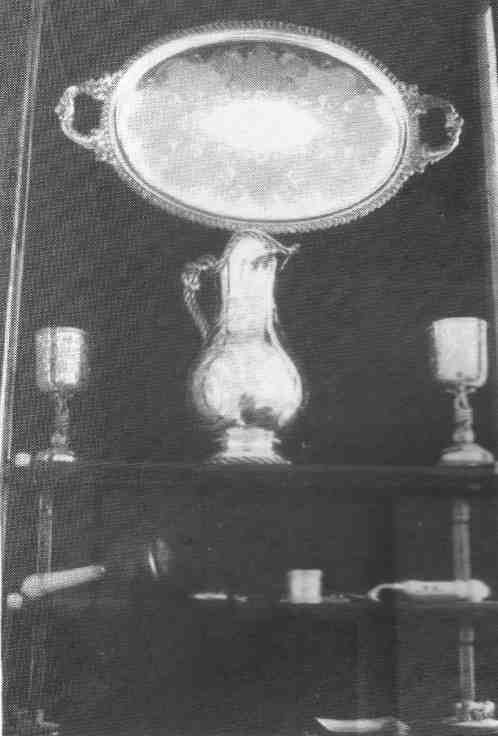
Thomas Hope
memorabilia |
All eyes were riveted on the proceedings as
"A leaden box, hermetically sealed, was placed in the cavity of the stone prepared for it. In the box was placed a document containing particulars as to the birth and death of the donor of the bequest, the object for which it was...; list of Trustees, copies of the Eskdale and Liddesdale Advertiser containing references to the donor and the bequest, and the Scotsman of Monday's date; as well as a number of British and American coins."
(Eskdale and Liddesdale Advertiser 23rd September 1896.)
Would this casket reveal the exact house in which Thomas Hope's birth took place?
The ceremonial continued with the presentation to Miss Hope by the contractors of an inscribed silver trowel for the purpose of touching the bed of the stone, which was then lowered into place. Miss Hope was then presented with an ebony mallet, the ivory handle of which was mounted with silver. She gave the stone "three distinct taps signifying that the stone was truly laid."
The trowel and mallet are lodged in Langholm Town Hall: |
Miss Hope's presence at the ceremony was warmly acknowledged by the first speech of the day, made by Colonel Malcolm, who went on to say that, although the Hospital was not yet functioning, welfare work was already being conducted by the Thomas Hope Trust: "It was in the year 1893 that the first portion of this munificent bequest was handed over from the far side of the water to the Trustees and that by a clause in the Will we were enabled in December of that year to commence to relieve such persons as came under the terms of the bequest. I may remind you that it was Mr. Hope's intention at first that relief should only be given inside the building, but when it was pointed out to him that this was not very desirable, the bequest was made that, when an amount sufficient for the building was secured, the Trustees could go outside and relieve such as they thought worthy in their own homes, and I am happy to say that in December 1893, the first person so relieved in the town was one, I believe, who had been a schoolfellow with Mr. Hope"
As Miss Hope's "oldest friend in Langholm" Mr. Smellie replied on her behalf. He related how he and Mr. Hope had looked upon the site purchased for the Hospital, he had confided: "I left Langholm with nothing in my pocket, but I resolved as time went on whenever I was able to do anything, to do something for Langholm, my native place!" He was also taken into confidence by Miss Hope, he revealed, when litigation was brought in an attempt to retain the funds in America: "before the case was settled Miss Hope twice said to me that if the trial went against Langholm she was prepared, though the cost amount to £50,000, to hand over the money to build the hospital in accordance with the desires and wishes of her brother." (By the terms of the will she was the largest individual beneficiary, receiving $30,000: thus she was prepared to hand over to the cause a sum larger than her inheritance.)
The following is the newspaper description of the Hospital:
"The building was erected from competitive plans by Messrs. Woodd and Ainslie of 35 New Bond Street, London. It is in the Border style of architecture and is carried out in plain and bold style. The walls are of bull and rock-faced work, with coins and principal stones in bold tooled work, with fine proportioned gables, pediments, and circular dormer windows. There is a tower and turret, finished off with battlements, the height of the tower being 45 feet from the street level.
The main entrance to the building is from Market Place by a main corridor 7 feet wide through the administration block, which contains on the left the doctors' room, communicating with the operating room, with lavatory adjoining. On the right is the visitors' room. Further on you have the mortuary passage which communicates with the operating room and corridor of the hospital proper. To the left you have the women's section which contains a corridor 6 feet wide, off which there is a convalescent room, 2 single bedrooms, nurses' duty room and large 5-bedded ward at the extreme end of the corridor, and lavatory wing, which contains bathroom, w.c., and sluices, with foul linen shoots. Coming back and taking the corridor to the right, you have on the right the dispensary with an entrance from Charles Street (Old) for dispensing to outside patients. On the left you have the matron's room which separates the men's and women's sections.
Now you enter what is called the general staircase and corridor. Straight forward through the swing doors you have the men's section, containing the same accommodation as the women's, with an entrance from Charles Street (Old). On the left is the staircase to the servants' bedrooms on the first floor. On the second floor there is a tank room, box room and stair to turret. To the right of the corridor you pass through swing glass doors into the kitchen wing, which contains in the basement four apartments for heating furnaces, etc. On the ground floor there is the servants' room or hall, pantry, grocery stores, kitchen, scullery and cook's pantry.
On the second floor there are 3 bedrooms with bathroom, w.c. etc. You pass out of the kitchen into a covered way where there are larder, coal and wood cellars. Then there is the laundry adjoining, which contains receiving room, laundry, with hoist to drying stoves and ironing room above, off which there is a sorting and mending room, with hoist down to the delivery room.
This building faces Charles Street (Old). The building throughout from foundation to ridge is being carried out in the most substantial manner possible, the best of all classes of material being used. The estimated cost of the building exclusive of site is £17,000."
| The contractors were: |
| Mason | Mr. Thomas Telfer, Langholm |
| Joiner | Mr. Matthew Knox, Langholm |
| Plumbers | Messrs. Wallace and Allan, Langholm |
| Plasterers | Messrs. J. Bell and Son, Langholm |
| Slater | Mr. Matthew Cowan, Langholm |
| Painter | Mr. John Goodfellow, Langholm |
| Blacksmith | Mr. John Telford, Langholm |
| Heating | Messrs. Benham and Sons, London |
| Mosaic Tilework | London Firm |
| Wrought Ironwork | Peard and Co., London |
| Measurer | Mr. Colin Young IM, 252 West George Street, Glasgow |
| Clerk of Works | Mr. R. K. Duncan |
Mr. H. Graham in toasting the contractors, local men in the main, made a speech which is well worth reiterating today, over a hundred years later:
"The work has been so done that for years after, aye for hundreds of years to come, the Hope Hospital will stand a lasting memorial to the tradesmen and workmen of Langholm today."
An interesting commentary on the sterling workmanship of the local tradesmen was provided by Wull Copeland who said that his father, a young apprentice with the building firm, told him that "the master mason got a 1d an hour for carving the ropework on the building", and it is said that the mosaic floors were laid by an itinerant workman.
| The craftsmen and labourers who built the hospital |
Rounding off the activities of that momentous day of celebration in 1896 a dinner for over a 100 was held in the Temperance Hotel at which W.E. Malcolm proposed a toast to "invincible determination" as exemplified by Thomas Hope.
From that point in September 1896 when almost every detail of the day was recorded until December 1926 when the earliest known surviving Minute Book of the Hope Trust begins, the only sources of information are the Patients' Registers, some Letter Books and such newspaper accounts as have been found.
The First 50 Years
The marble plaque in the administration corridor reports that the Hospital opened on 28th May 1898, while according to the Admission Register, patient number 1 - a nurse, interestingly enough, was admitted on the 3rd December 1898 through Dr. S. Phillips (whose name does not appear in the register beyond 1899). One can merely speculate on the causes of delay over opening when the event appeared to be almost imminent in 1896: Mr. Malcolm had said:
"The building is certainly not quite finished, and there are no inmates in it as yet, but I may say that it is a fair way to be so."
Were there contractual difficulties? Or were there staffing problems?
In the absence of Minutes to ratify that the money was all paid over in 1894 one can only assume that it was. This being so, the terms of the Will were: "the said building shall be erected and completed within three years from the time when the whole of the said revenue shall have been paid." It is most likely that the building was "completed" by 1897, though not functioning because it is hard to imagine that the Trustees, shrewd as they were, would have failed to observe the exact letter of the Will in view of the previous litigation.
The second patient happened to be the hospital cook, Alice Bayley, also a patient of Dr. Phillips, and admitted on December 17th. Janet McLean, a housemaid, a member of staff again, was the sixth patient, Dr. Gill had her admitted on 25th February 1899.
Admissions, it will have been deduced, were not numerous in those early days. There were only seven patients in the first six months. However, as time went on there was a growth in use of the facilities.
| YEAR: | | ADMISSIONS: |
| 1900 | | 5 |
| 1910 | | 37 |
| 1920 | | 47 |
| 1930 | | 149 |
| 1940 | | 121 |
| 1948 | | 80 |
Outpatients were also being treated, for the years when records exist 18 was the maximum recorded.
The medical men of the area performed minor operations, such as tonsillectomies, amputations of digits, straightening hammer toes, removal of cysts and certain tumours, circumcision etc., at the Hospital. (In 1928 a letter was sent to them objecting to the use of the operating theatre late at night and on Sundays asking them to refrain from this practice except in extreme emergencies).
Major surgical cases would be transferred to Carlisle or Edinburgh and sometimes returned to Langholm for post-operative care; at times a visiting surgeon mostly from Carlisle, such as in the early days Dr. Lediard, Dr. McLaren, Dr. Syme, would operate in Langholm. From the end of World War I names like Dr. Dunlop, Carlisle, Dr. D. Chiene and Mr. F. Jardine from Edinburgh and even Dr. P.M. Kerr from Dumfries began to be recorded as surgeons in the Hospital.
In the absence of contemporary documentary evidence, the main clue to the name of the first Matron is contained in the Minutes for August 1936, strangely enough, when it was declared that the hospital sewing machine had worn out, it was recorded as having been left behind by Miss Clyde, the first Matron. The duration of her term of office was probably four years, assuming that there was no-one between her and the (first) Miss Robertson, of whom there is marginally more information available.
Staffing at the Hospital would be minimal in the early years because, as has been already indicated, there were few patients. Apart from Matron, the cook and housemaid, the only other members of staff would have been a probationer nurse and a male caretaker. All would have lived on the Hospital premises. By 1916 there were two probationer nurses.
Staff were entirely under the control of the Governors and Trustees, who were directed in the words of Thomas Hope's Will "to select, nominate and appoint proper persons to be...surgeon, nurses, servants and others...to perform such duties for such periods and with such salaries, wages or emoluments as the said Governors and Trustees shall from time to time think fit to appoint, and with full powers to them to dismiss any or all of such persons so appointed at such time and manner as the said Governors and Trustees shall think fit."
Colonel W.E. Malcolm of Burnfoot, a former Chairman of the Trust, died at the age of 90 in 1907 having been presented just a few days earlier with his portrait in oils in recognition of his many years of public service. One concludes that Rev. David Maxwell of Broomholm, son of George Maxwell, one of the original trio of Trustees, then became Chairman from the fact that, when in 1934 photographs of previous Chairmen were being sought, his photograph came to the Hospital. Rev. David Maxwell of Broomholm died in 1916. Henry Graham of Holmwood, having died in 1909, was almost certainly succeeded by his son, Fred, as a Trustee.
By 1910 when the first Letter Book is available Mr. William Elton, the Assistant Secretary, was handling Trust matters for Mr. Smellie: in one letter he told his correspondent to address letters to him as 'communications addressed to Mr. Smellie are apt to be overlooked or misplaced'. Mr. Elton succeedeed Mr. Smellie when the latter died in 1913 at the age of 94 years.
In the early years of the 20th Century there appear to have been two doctors' practices in Langholm, that of Dr. I. Mason, a middle-aged man who died suddenly in 1904; Dr. F. Hendry Rae, who succeeded him, moved south in 1909 when Dr. R. Watt took over. The other practice belonged to Dr. John Gill, Rosevale,' who died at the age of 59 in April 1914:
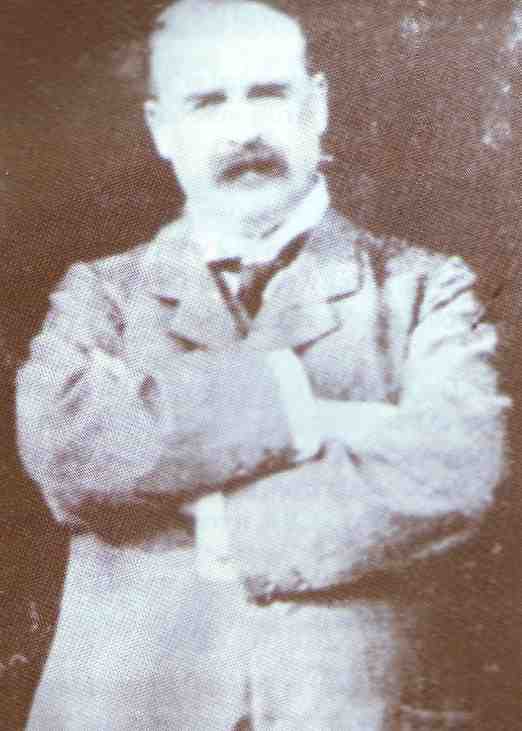
Dr. John Gill
General Practitioner
1880 - 1914
(From 'Oor Gait-En' by David Beattie) | xxxxxxxxxxxxx | DR JOHN GILL.
For 34 years a Medical Practitioner in Langholm.
He died 28th April, 1914.
Come, mourn with us, ye heath-clad hills that grace
Our Border glen,
For lost to us is a familiar face -
A prince of men.
A man of tender heart and noble mind,
To those in need
He was, what in mankind we strive to find -
A friend indeed.
Of genial, kindly, unassuming ways,
His constant thought
Was for the poor; nor did he seek the praise
His labours brought.
To fellow-man, what rank it mattered not,
He was the same;
And spent a life, unselfish and begot
An honoured name.
. . . .
Till dawns the morn, he sleeps where daisies grow,
'Neath Warbla Hill,
Where, save the Esk's faint requiem heard below,
All, all is still.
|
"It is with profound regret that we have to record the death of Dr. Gill which occurred at the Hope Hospital today (Tuesday 8th April). The deceased gentleman was seized with a paralytic stroke while attending his patients at the Hope Hospital on Saturday April 4th Dr. Gill, having come to the town in 1880 and having thus served 34 years, was honoured by a memorial in Langholm cemetery which states: 'Erected by the people of Langholm and neighbourhood in grateful remembrance of a life of self-denying devotion to duty.'"
(Eskdale and Liddesdale Advertiser April 29th 1914)
One is left wondering why Dr. Gill did not appear to be present at the laying of the Hospital's memorial stone.
According to correspondence of 1912, the Trust purchased some condemned property of the late R. T. Scott at nearby Kilnknowe. Then in July 1913 the Trust applied to the Town Council for permission to:
1 take down and rebuild the wall in Charles Street (Old) - part of which skirted
some "recently purchased garden ground" (Correspondence of December 1913
suggests that it might have been purchased from Mr. Smellie);
2 to take down the old buildings on the property of Kilnknowe*;
3 to continue the parapet wall topped with iron railings in front of the Hospital;
4 to erect a fence on the south side of the lane in Kilnknowe
It was to be over two years before the scheme was completed.
Firstly there was a lengthy dispute with the Town Council over the wall in Charles Street (Old), which was resolved only by the Municipal election of November 1913 in that the outcome was "a win for the party in the Town Council who supported the proposals of the Trustees": that is, the Trust did not as a result build a wall as far back as a number of former councillors had wanted, a move whereby the Town Council would have acquired from the Trust a strip of land in Charles Street (Old) about '80 or 90 ft. long and 7 or 8 ft. broad' which would have had the effect of leaving the Hospital laundry projecting into the street about 7 or 8 ft.
*Kilnknowe was the name of a specific property as well as the name for that part of town. The buildings which were demolished were almost certainly those standing in front of the Hospital as seen in the picture of Irving's Close, and also the buildings on the other side, leaving only Carruther's property.
Then there were protracted, abortive negotiations with Mr. C. Carruthers, who owned the watchmaker's shop on the other side of Irving's Close from the Thomas Hope Hospital, for the purchase of his property. The Trust were hoping to complete the acquisition of the row of properties by the deal.
Finally in February 1915 an article in the Eskdale and Liddesdale Advertiser reveals that Mr. Elton is applying on behalf of the Trust to the Town Council for "an extension of the time for their hoarding in David Street". The reason given being that "the contractors had had great difficulty in getting men for the work"; it seems, too, that the Trust was cherishing hopes that Mr. Carruthers would change his mind. Mr. Elton is quoted as commenting bitterly that "but for the unfortunate breakdown of negotiations between the Trustees and Mr. Carruthers*, they would have been able to make a very marked improvement", an improvement which was only realised half a century later.
In 1913 the question of acquiring an ambulance was under consideration. The Trust was on the look-out for something "light and easily drawn by one horse in a country district". It took two years to track down "just the article my Trustees require," wrote Mr. Elton; it was purchased for 50 guineas in Aberdeen. Sadly, experience dulled the initial satisfaction: "immediately it gets outside the town a couple of horses are necessary to pull it. The main fault, however, is not its weight or accommodation but its uncomfortableness." (Having made several abortive attempts to sell it, it was finally taken up by the Dundee Branch of the Scottish Red Cross when offered as a gift in 1918!)
In addition to the world-wide engagement of the forces of war, 1914 saw the outbreak of another conflict, a local one, which was sparked off by the afore-mentioned death of Dr. Gill, the result of which was that there was only one medical practice left in town, that of Dr. Robert Watt.
Just over a fortnight after Dr. Gill's death a notice, inserted by Provost Easton, appeared in the local paper of May 13th calling a public meeting that night in the Temperance Hall "to consider what steps, if any, be taken to secure and Independent Doctor for Langholm and district." The response was tremendous: it was "a crowded meeting, a good many people being unable to get into the Hall."
(Report by Robert Hotson.)
NOTICE
A PUBLIC MEETING
Of all interested in getting an
INDEPENDENT DOCTOR FOR LANGHOLM AND DISTRICT,
will be held in the
TEMPERANCE HALL,
At 8 o'clock,
ON WEDNESDAY EVENING,
13TH May, 1914
R. SCOTT, PRINTER, LANGHOLM
Dr. Watt's son, George - later to serve Langholm as a G.P. himself - said candidly: "Perhaps it was partly my father's fault for standing on a Tory platform in a Liberal stronghold!"
* 1 incidentally, later on in 1938 the question was posed "Should Mr. Carruthers be employed as a clock winder in the Hospital?"
Mr. Scott retorted: "There are only six clocks in the Hospital. The caretaker is quite able to do this work."
2 A grandfather clock bearing the name of Carruthers still stands in the day patients' sitting room at the Hospital.
The almost unseemly haste, with which the opposition concerted its action, was necessitated by the fact that "they were told by circular within fourteen days they would be put on Dr. Watt's panel."
(Eskdale and Liddesdale Advertiser's review of the case on November 25 1914.)
Yet by the terms of the National Insurance Act of three years previously they had a right to a choice, they argued.
The fact that Dr. F. Gibbs was already acting as Dr. Watt's assistant, according to the Admission Register, does not seem to have affected attitudes.
| Dr. Robert Watt | | Dr. Andrew Calwell |
| General Practitioner | | General Practitioner |
| 1909 - 1950 | | 1914 - 1939 |
XXXXXXXXXXXXXXXXXXXX
NATIONAL INSURANCE COMMITTEE
FOR DUMFRIESSHIRE
NOTICE TO INSURED PERSONS
MEDICAL BENEFIT-CHANGE OF DOCTORS
NOTICE IS HEREBY GIVEN, that every insured Person
who wishes to select, for next year, a Medical Practitioner
other than the Practitioner upon whose list the name of
such Insured Person now is, must personally give notice
of such wish to the undersigned not later than the
1st December, 1914. Every such notice must —
(1) state the full name of the present address Insured Person his or her proved society and number therein, the Medical Practitioner upon whose list his or her name now is, and the
Medical Practitioner to whose list he or she wishes to be
transferred:
(2) be in writing and be signed, and transmitted by the Insured Person to the undersigned; and
(3) be accompanied by the Insured Person's Medical Card.
A notice which does not fulfil these requirements may not
be accepted. A form of notice may be obtained by any Insured
Person on application personally or in writing to the under-
signed.
Insured Persons who do not give notice as above of their
wish to change their Medical Attendant shall be deemed to
have elected to continue their present Doctor for another year
or until they remove their residence to another district.
JOHN ROBSON, Clerk of the Committee.
County Buildings, Dumfries,
10th November, 1914
The Eskdale and Liddesdale Advertiser, November 18, 1914 |
Dr. Andrew Calwell arriving from Mainsriddle on the Solway took up residence at Clinthead. As Dr. George Watt said: "It angered my father that the newcomer didn't have to buy his practice." 600 names were collected for the new panel: alas, the petition's heading was unacceptable to the National Insurance Committee in Dumfries, who declared that the signatories would have to remain on Dr. Watt's panel for the time being unless Dr. Calwell or the patient was prepared to pay for medicaments.
Returning to Dr. Gibbs, he last referred a patient to the hospital in 1915. "As he had a dental degree," said Dr. George Watt, "he became a dental anaesthetist, progressing to a Consultant's post at Edinburgh Royal Infirmary."
At the outbreak of war, approaches were made by the local Red Cross Society for the use of the male side of the Hospital.
In the end alternative arrangements were made.
It is not clear when the Trust began to employ a district nurse to treat Trust out-patients. In 1911 Nurse Bertha Roeber was occupying this position. In a letter to Dr. Watt the Trustees expressed their displeasure at learning that Nurse Roeber had attended unmarried mothers in childbirth: the practice was to cease unless it was a life or death situation!
Later in 1914 when she asked for a pay-rise it transpired that her activities were controlled by a Ladies' Committee who had retained no record of the terms on which she was employed. Nurse Roeber, having been granted £45 per annum, was told to expect no further increases in salary.
As this German-born nurse experienced open hostility in war-time Langholm she chose to return to Germany in 1915.
(In 1923 Nurse Roeber appealed to the Trust for financial help: the Hope Trust Constitution forbade the members from responding. However, Mr. Elton made an appeal on her behalf to the Queen Victoria Jubilee Institute for Nurses.)
Meanwhile a temporary Trust Nurse filled the vacancy for a period until a permanent appointment was made in September 1915, when Miss Elsie Innes took up the post. Nurse Innes, unlike her predecessor, was resident at the Hospital where she could be supervised by Matron and assisted when necessary.
|
Thus the Ladies' Committee (Mrs. Buchanan, the Manse, and Mrs. Scott, Ashley Bank), became redundant.
The office of caretaker became vacant in 1916. Mr. Walter Plenderleith was appointed in May at a wage of £1 per week, plus free house and a £5 allowance for coal and gas. His duties were detailed as follows: "to attend the furnaces; to keep the whole grounds and garden in good order...;to clean out the filter bed...;to supply coals for the Hospital and the wards; to clear away ashes; to polish the ward floors at stated intervals; to bathe male patients; and do other duties as required." One other duty, which emerges from the Letter Books, was the occasional train journey, for instance, to Glasgow to accompany an epileptic back to Langholm.
A telephone was installed at the Hospital in 1916. The number was "17", an indication of the limited number of telephones in the district; it is no surprise that these two digits are at the end of the considerably larger number of the Hospital's today.
An old sore re-opened in 1917 on the calling-up of Dr. Calwell by the Scottish Emergency Committee, who declared that his practice would be carried on by Dr. Watt and an assistant unfit for medical call-up. Dr. Calwell asked for a "suitable substitute". A local tribunal hearing the case brought by Dr. Calwell's panel patients granted exemption until a "suitable substitute" could be found. Thereupon a military representative brought an appeal against the decision before the Tribunal for Dumfries and Galloway where what was dubbed as the "unfortunate squabble" had another airing and was reported extensively in all the county's newspapers in June 1917. The military representative's appeal was sustained.
Dr. Calwell, however, still had not quit the scene in May 1918 as evidenced by his signature in the Hospital's Admission Register. Meanwhile Dr. Watt received his call-up papers: by March 1918 his signature ceased in the Register. "My father was never posted overseas. He only made it as far as Glasgow when hostilities ended," said Dr. George Watt laughing.
For a very brief period unfamiliar medical names, like Norman Leys, R. Davidson and A. Benham-Stich, adorn the Register.
At this time (December 1918) a baby girl was born in Langholm Hospital, the first to appear in the records, though it was not recognised as a maternity hospital. Incidentally, of the few children happening to be born at the Hospital, three were born to the same woman on different occasions in the 1920's. (Early in 1928 Dr. Watt complained that one of his patients was unable to gain admission to a private ward because it was occupied by a maternity case. He posed the pertinent question whether the Hospital was registered under the Midwifery and Maternity Homes Act. The Trust was obliged to ban maternity cases.)
The first available Hospital Minutes, those for 7th December 1926, reveal that the Quarterly meetings of the Trustees was held in the Hospital Board Room, the first room on the right at the main entrance, at 2p.m. prior to the monthly Hospital Executive Committee meeting. Present were Arthur Bell, Chairman since 1916 and owner of Buccleuch Mills; Brown Douglas; Palmer Douglas of Burnfoot, son-in-law of the first Chairman; A.M. Scott; Major E.J. Bell, son of the Chairman; and Mr. Elton, the Secretary. (A.M. Scott and Major Bell had been appointed in September 1924 following the deaths of Mr. Sanders and Mr. James A. Scott.)
Under consideration that day were the annual accounts. Income amounted to £4,474,13s
(1s = 5p): it accrued mainly from loans and investments; after 1910 there was a modest income from paying patients, who were charged at a rate of one guinea per week until 1920 when it was raised to 5 guineas, though reductions were permitted. (Prior to 1910 fear of having to pay Income Tax prevented such a course.) In 1928 the Minutes record that "the secretary was instructed to write Mrs.—— and point out that the Hospital was not meant for persons in her class of life, and requesting her to state what sum she was prepared to pay.
Expenditure in 1926 totalled £4,461,10s: as well as Hospital running costs this included allowances to the needy whose case would come up at two successive meetings before being added to the Trust pensioner roll, if approved.
Apart from Hospital staffing (including the Hope Trust district nurse) and running costs expenditure took the following forms...Trust pensioners, apart from receiving a weekly allowance of from 2s 6d (1s = 5p 6d = 2½p) to an upper limit of 15s, as agreed in 1917, would qualify for Trust payment of optical or pharmaceutical expenses for instance. As from 1915 the system of payment of doctors altered: instead of being paid for each case attended, it became an annual capitation allowance of 1 guinea for the 122 patients on the roll at that time; in 1929 it was raised to £1.11s.6d per patient, plus a mileage allowance if the patient were at least 4 miles from Langholm. Occasionally doctors would make an application (almost always successful) for a grant towards the renewal of certain instruments.
Another regular charge against the Hope Trust account was subscriptions paid to other institutions, such as the Cumberland and Westmorland Convalescent Home at Silloth and the Border Counties Home for Incurables, for caring for local cases.
At the meeting of December 1926 a decision was taken to install electric lighting to replace gas lighting. In the absence of a national grid or even a company supplying electricity, this move, early and progressive for a Cottage Hospital (Crichton Royal Hospital in Dumfries began the installation of its electricity plant in 1894.) of course involved purchasing a generating plant. The tender of £705 submitted by Messrs Greenwood, Thomson and Co. was accepted. The Trust took the precaution of insuring the plant and fittings for £800.
The following year an electric floor polisher was purchased. None of the other Cottage Hospitals in the South West could boast such conveniences at this stage.
Discussions about the cost of fuel took up much time at committee meetings, especially at the time of the annual appointment of a supplier and carter (a joiner, mason, plumber and painter would be nominated too.) Supplies of solid fuel were required to keep the Vulcan Boiler, purchased in 1922, stoked for heating purposes; to run the cooking stove; and to fuel coal fires which burned in the tiled grates in the side rooms, wards and operating room when necessary.
According to Miss Alice Mann, later to become Matron, the interesting low-level corridor recesses served the purpose of storing coal buckets. Two other interesting features - in the operating theatre until the alterations in the 1980s - were the pivoting radiator and the heavy slate doors on the cupboard, presumably a safety feature to protect volatile materials within. It was unusual for a Cottage Hospital operating theatre, planned in the 1890s, to be equipped as this Hospital was, with such advanced features as channels to permit hosing down to take place.
In 1927 it was discovered that a crayon portrait of Thomas Hope, the founder, was in need of repair. The suggestion was that Mr. John Bell of Hillside, grandson of the Chairman, having trained at Art College might be asked to make a copy in oils. When the portrait was executed, Mr. Bell's family connections notwithstanding, he was asked, as the Minutes record, "to try to tone the portrait down a bit!" (Mr. Bell later moved away to join the artistic community at Kirkcudbright, where he lived until his death in the 1980s.) The portrait, for which he was paid 7 guineas, still hangs in the main hallway of the Hospital.
In the period from 1920 a series of Dangerous Drugs Acts came into force. Dr. Watt in 1927 drew the attention of the Trust to the need for a drugs register to be kept at the Hospital. In October of that year Matron was instructed to keep a register of such drugs as were available only on a doctor's prescription.
The Minutes for October 1927 also record that "Mr. Scott brought before the meeting the fact that Miss Robertson had completed 25 years of service as a matron." In recognition of this fact she was presented with a roll-top desk in December: "
In making the presentation Mr. Bell said that Miss Robertson had discharged her duties during the long period of 25 years with entire satisfaction not only to the Trustees but also to the Medical practitioners and the patients themselves and they all greatly appreciated the efficient manner in which she managed the Hospital. The desk was only a small mark of their appreciation of her services and he trusted that she would long be spared to use it and carry on her work in the Hospital." Only three months later she was obliged to resign (as from 1st June) because of family circumstances.
Before quitting office Miss Robertson's only known recorded protest came when she brought it to the Trustees' notice that doctors were asking the District Nurse, Miss Innes to perform 'last offices'. The Trustees expressed their disapproval.
Prior to Miss Robertson's departure interviews of four candidates took place to find her successor. Miss Amy G. Moffat from Annan was appointed at an annual salary of £80, plus £10 uniform allowance. Miss Moffat was permitted the luxury of re-furnishing her room, to which end she went on a shopping to Carlisle and spent £55. Soon afterwards her request for new bed linen and blankets for the Hospital was also granted.
Admissions to the Hospital were very strictly controlled by the Hope Trust in accordance with Thomas Hope's own wishes, it will be recalled. Nevertheless, a present-day reader of the Minutes is bound to feel concern at the interpretation of those wishes.
For instance in June 1928 three cases were brought before the Trust for consideration. The first had been knocked down by a car: there was suspicion as to his mental state and thus his doctor was requested "to furnish a certificate forthwith on soul and conscience that he was not mentally affected", otherwise he was to be "removed from the Hospital forthwith". A second, an asthma case, was deemed to have been in the Hospital long enough (a few months) and the order was given for his removal. (Yet a blind patient whose fees were paid by the Royal Asylum was given 6 months' board the following year: therefore the timespan of a stay in Hospital could be prolonged.) A third, according to Matron, was being treated for diseases other than those mentioned in the Register. Dr. George Watt's interpretation was that it might have been a cancer as none were permitted to remain in the Hospital. Such cases sound harsh to the reader but all the facts are not known. Besides, other cottage hospitals had similar rules to guard against prolonged occupations of beds. (It is interesting that in 1916 a proposal to rent and furnish a house for patients not eligible for admission to the Hospital was considered but never approved.)
A decision was taken at that same meeting in June 1928 to draft a new set of hospital rules and a new admission form: the resulting documents would be sent to the local doctors. Dr. Watt wrote and said that he would not comply with the new rules. Adding fuel to a situation already inflamed, Trustee Mr. F. Graham gave notice at the October meeting "that at the next meeting he would move that all operations on the doctors' patients for tonsils and adenoids be not allowed in the Hospital". The motion was carried. Dr. Watt appealed to them to reverse the decision.
No full copy of the rules, old or new, has come to light, not even in the British Medical Association (B. M. A.)records. However, a letter of September 1910 records: "The rules provide that patients, except in urgent cases of accident, etc., can only be admitted to the Hospital on the authority of one of the Trustees, and that the form of admission must be signed by one of the Trustees and also by a doctor practising in Langholm. " The doctor's certificate had to confirm that the case was not affected by infectious disease or insanity. From 1928 the rules, according to a letter of June of that year, had been amended to exclude any patient "suffering from any infectious, contagious, venereal, chronic or incurable disease, or who in any way were mentally affected."
Dumfries and Galloway B. M. A. was brought in to discuss the Hospital rules. The Minutes of the Executive Committee of the B. M. A. for November 1928 reveal that Dr. Calwell had corresponded with them, too, on this heated subject but his views are not recorded. It appears that the Hope Trust yielded some ground a propos the admission forms by agreeing to study those of D.G.R.I. and to reconsider one rule in connection with 'chronic cases'; but on the tonsil/adenoids§ rule they were intransigent. The new set of rules and admission forms, having British Medical Association approval, were printed in June 1929 and issued to the doctors on 27th of that month.
It looked like an amicable solution. But on that very day, the 27th June 1929, a crisis erupted, necessitating the calling of a special Trustees' meeting on the 28th. Dr. Watt had had the affrontery, as the Trustees saw it, to attempt to have a patient admitted without signing an admission form. He had said on the telephone to the Secretary that he would put the patient into the Hospital in spite of the Trustees, who had instructed the (acting) Matron to lock the doors and gates against Dr. Watt. The latter had then declared the patient to be an emergency case, a move which gained her admission between 4 and 5 p.m. yet, the Trustees contended, neither Dr. Watt nor his assistant had visited her up to 11 a. m. that day (28th).
Dr. R. Watt's version of the story was the case was an emergency: the widow "was suddenly taken ill with acute pyelitis and suppression requiring the immediate application of hot packs to prevent the onset of uraemic coma"; that the Secretary, Mr. Elton, brought a policeman to prevent the patient's admission; and that the acting Matron did not have the new set of rules to discover emergency procedure.
|
§ In regard to tonsil/adenoid cases, from 1911 through to 1928 there were occasions when a visiting surgeon would deal with a quantity of such cases. The new rule terminated this practice.
An enquiry then came from Dr. Richie, Medical Office of Health for Dumfriesshire, in April 1929 to discover whether the Trustees were prepared to enter into an arrangement for such operations involving school children whose parents could not afford the surgeon's fee. The request was turned down on the grounds that accommodation could not be guaranteed. |
The B. M. A.'s appraisal of the situation was that it was regrettable that Dr. Watt had had this particular case at this particular time. They did not consider the case to merit emergency status, however Dr. Watt was to be asked if he were prepared to adhere to the rules, a course of action which they recommended. Finally, they deprecated most strongly the threat by the Trustees of comprehensive exclusion of Dr. Watt's patients from the Hospital. A measure of rebuke had been meted out to both sides in the dispute which rumbled on until the October with Dr. Watt seeking a definition of emergency cases and pressing for tonsil/adenoid cases to be admitted. In the former situation the B. M. A. were to act as arbiters when necessary, while on the latter the Trust remained obdurately opposed to the idea.
As if one thorny issue was not enough another problem, the reason for an "acting" Matron having had to handle the preceding crisis, had reared its head in the interim. Back in April another special meeting had had to be called to consider a mother's complaint that her probationer daughter had only 5 weeks' day duty in 5 months. Matron Moffat and the probationer were called to Holmwood to the meeting: Matron refused to attend.
The Trustees ruled that:
1 the two probationers and the staff sister should all share night duty;
2 a senior member of the staff should be in range at all times;
3 patients on the point of death and those emerging from anaesthetic should be attended by senior staff.
In the absence of a satisfactory explanation by Miss Moffat to the above charge, the Committee called for her resignation. Her refusal was accompanied by the threat that her staff would leave with her. Matron was given three months' salary from 31st May in lieu of notice. Contingency staffing plans were made in case the staff proved loyal to Matron, as indeed happened: Sister Weir and probationer Mercer left at the end of June.
Having approached Glasgow Nurses' Club to recommend candidates for the vacancies, the position of matron was awarded as from 6th August to Miss Jessie Robertson, Matron of the Cottage Hospital at Campbeltown, at a salary of £120 per annum plus a uniform allowance. The new staff sister was to be Miss Ina Brown whose salary was to be £65 - £70, plus a £5 uniform allowance.
The appointment of Trustees was confirmed in 1929: they were R. Hamilton, the Schoolhouse; Mr. T. Paisley, Elizabeth Street; Commander C. MacConnachie RN, Carlesgill; and Mr. H. Robson, Alma Place. The formal adoption procedure followed was that "a deed of assumption in favour of the new Trustees was produced and a minute of acceptance thereon was signed by the new Trustees."
In 1929 a new probationer also came to the Hospital, where she served out the customary 2-year probationary period. She was Margaret Boyd. Still living in Langholm, hers is the earliest first-hand account of life there. "The nursing staff consisted of Miss Jessie Robertson as Matron, Sister Brown and two probationers, Isobel Hounam and myself. Miss Robertson - she had been in the Queen Alexandra Nursing Service in the first World War - was good at training nurses. She looked after her nurses very well."
"Then there was Cook. She had to be up between 4 and 5 in the morning to clean the flues of her big black stove and blacklead it. There was one housemaid, she cleaned out and polished all the beautiful tile fireplaces and washed the blue, green and white mosaic floors in the corridor every day, though not all the domestic work was left to her. We all turned our hands to anything in those days. Miss Robertson herself did quite a bit of cooking. All the rooms and wards had lovely parquet flooring. The gardener used to come in once a week to polish them with the polisher and then we maintained it for the rest of the week."
"A woman came in once a week to do the laundry - the laundry was where the Health Centre is now. There was an old-fashioned boiler with a fire below to heat the water - we eventually got a washing machine in the late forties. Upstairs in the laundry was a drying room. The woman came back on a Tuesday to do the ironing and if we were not too busy we would help." (Incidentally, Miss Mann and Tom Graham the builder - of whom more will be said later - both marvelled at the box mangle which used to be in the laundry. It was as big as a billiard table and a box of stones smoothed the washing.)"
"The two probationers did night duty month about. It was a big responsibility but sister was on call. I remember being terrified at first because some of the patients did a bit of wandering. It was the night nurse's job every Monday to set the chimneys on fire to clean them. I was always very nervous about it."
"The four side rooms were meant for private patients but we didn't get many. Other cases used them. They were always full because there was a big turn-over."
"Looking back I can see that the work was heavy but we were quite well looked after. The food was good - nothing lavish. (I was half starved when I did my midder - elsewhere of course!)"
"The Trust kept script control of finance. I remember they wouldn't let Miss Robertson get wallpaper for her sitting room. She also asked for an electric blanket for shock patients but didn't get it. She was quite indignant when she got a little pad instead!"
"Theatre work was according to demand. Mr. Caird, Mr. Hartley, Mr. Dunlop and later Mr. Venters came up from Carlisle."
"The electricity plant was a good thing to have. The porter used to charge it up twice a week and also on the days before and after theatre."
"In mid-1932 when electricity supplies were becoming fairly generally available within the county, arrangements were made with 'Dumfries Electrical Committee' to put in a standby connection to the electric lighting plant in the Hospital for use in emergencies. Two years later the Trustees proceeded to install electric bells in the wards to eliminate the disturbing practice of ringing a hand bell. In 1937 night lights were fitted in the wards."
The vexed question of tonsil and adenoid operations rose again in December 1932. It was decided to allow each doctor in the town two days in the year for operations of this nature, the days and time to be fixed to suit Matron's convenience.
A problem over the cost of medicines supplied to patients in the Hospital was highlighted in 1933. Reference was made to a Minute of 1915, 'when it was agreed that medicines and dressings should be supplied to all patients in the Hospital who were unable to pay for the medicines themselves.' At issue was the fact that no ceiling had been fixed: so recently one patient over a period of seven weeks had received £5.8s worth of medicine. After due consideration it was resolved that "No Trust Pensioners who were also Panel Patients who had been admitted to the Hospital should be supplied by the Trust with medicines and dressings, and that these patients must be supplied by their Panel Societies with the ordinary Panel Medicines unless in special circumstances where a special request in writing was made stating the grounds upon which the application for ordinary full medicine was made by the Doctors to the Trustees or their Secretary for the privilege.
Mr. Fred Graham of Holmwood had been Chairman since the death of Arthur Bell in February 1929. After only four years in office Mr. Graham died, just a few months after the death of another Trustee, Captain Palmer Douglas. Mr. Arthur M. Scott succeeded Mr. Graham. Mr. Brown Douglas, "the oldest and a most valuable member" of the Hope Trust, died in June 1935.
Such losses may well have prompted Matron's suggestion that portraits of the Chairman of the Trust might hang in the Board room. (These portraits which were left in the Hospital in 1948 no longer appear to exist.)
Problems with the heating system in 1934 necessitated the employment of a Glasgow firm to upgrade the heating arrangements which cost £345 and took four weeks to effect. For the first time staff were provided with the luxury of a heated bedroom. A new Esse cooker cost £87, complete with 'auxilliary oven, back plate and rail', was ordered for the kitchen. The suppliers were asked to guarantee that it would cook for 24 people. In 1937 Matron applied for a refrigerator. Meanwhile in 1935 Wallace, the caretaker, was grateful for the installation of a new range which would supply the lodge with hot water. Upgrading of the sluicing arrangements for the large wards took place in 1936. Margaret Boyd reckons that must have occasioned the removal of the magnificent copper sluice surrounds (which Matron Robertson had incorporated into a table subsequently). "I remember that it was the duty of the night staff to polish them till they shone".
Two proposals around this time, which sadly came to nought, were the possible question of a motorised ambulance and X-ray equipment: the latter subject was brought up several times over the years but the preference remained for paying fares to Carlisle for the use of the facilities there.
Dr. George Watt joined his father in practice in 1935: he was already familiar with the routine, however since he had given assistance before going to Cumberland Infirmary as a House Surgeon the previous year.
Admission problems continued to surface, late in 1936 Dr. Calwell sought the admission of a baby with an 'incurable disease'. Dr. Calwell persisted although he had been flatly denied admission. Eventually the Trust relented but Dr. Calwell was warned that the result did not constitute a precedent.
In 1937 consideration was given to the closure of Irving's Close, the afore-mentioned little lane that ran parallel to Charles Street (Old). The Trust Secretary suggested "that the road was so little used that there might be no objection raised if the Trustees were to erect a gate at both ends of the road". In the end the matter was dropped due to the legal questions that might be raised.
A more serious matter in the eyes of the Trust had arisen in regard to the rates. "The valuation of the Thomas Hope Hospital appeared to be excessive considering the size of it, but the difficulty that had to be faced was the cost of the erection of the Hospital which would require to be taken into account, and which far exceeded the cost of erection of hospitals of a similar size." For instance, the 12-bedded Moffat Cottage Hospital, built for £5,100 was given an assessed rental of £61; the 31-bedded Castle Douglas Hospital, which had cost £5,200 was assessed at £125; whereas the 14-bedded Langholm Hospital, because it had cost £17,000 was assessed at£300, a figure exactly equal to that of the 100-bedded Dumfries and Galloway Royal Infirmary which had been erected for £14,389.10s. Protests from Langholm achieved a reduction of the assessed rental to £180: £165 for the Hospital and £15 for the lodge.
War Clouds Loom Over Europe
As the war clouds thickened over Europe again, Matron suggested the acquisition of pamphlets for the Hospital on the subject of gas warfare as a judicious move since nearly all such institutions were receiving instructions on the treatment of gas-raid patients. Also the Hospital playing host to Department of Health personnel who surveyed the premises to assess its potential for coping with a possible emergency.
During an interlude in the crisis preparations four new Trustees were appointed in October 1938, they were Commander Hoyle, Bogfoot, Ewes; Mr. T. Hyslop, Billholm, Westerkirk; Mr. James Bell, Hillcrest and Mr. James Knox, Barbank, both of Langholm.
Miss Robertson was detailed to make an inventory of Hospital needs in the event of admission of acute air raid casualties, inevitably questions were posed. If the Public Health or war authorities took possession of the Hospital would they take over staff and be responsible for financial costs? Who would be responsible for possible damage inflicted on the Hospital by enemy action?
An A.R.P. sub-committee of Mr. Knox, Mr. E. J. Bell and Mr. James Bell was formed. Various precautions were implemented. Oil cloth was purchased in case windows were blown out and cellophane, later replaced by fabric, was gummed to the windows. Key windows, such as that of the principal corridor looking on to the street, were sandbagged: the corridor was to be an area of refuge. Roof windows, especially that in the operating room had wire mesh frames fitted to the under-side to prevent glass falling down. Strips of black paper were pasted down the sides of windows where the blinds did not afford total black-out. Brick baffles were erected outside the main entrance and protection was also given to the lighting and heating plant, the pantry and the scullery. The arched area beneath the main wards was ear-marked for a public air-raid shelter, for which purpose it would require sand-bagging: Margaret Boyd said that this was never done.
Under the Emergency Hospital Scheme (EHS), operated by the Department of Health, extra beds were required. Margaret Boyd (having received a letter from Matron Robertson urging her to return to Langholm when she had completed her training in Glasgow in 1937) described the situation: "The number of beds was increased to about forty, there were beds in each of the side rooms, the offices, dayrooms and Board room were even filled with beds."
It was reckoned that twelve extra nurses would be required in an emergency situation. Some auxiliaries could be obtained through the British Red Cross Society, while as many as possible would be trained locally. The Trust indicated that they were prepared to co-operate with the training scheme provided the nurses would serve locally afterwards. Dr. Ritchie, the County M.O.H. pointed out that as they were voluntery workers they could not be compelled to work locally. In September 1939 training began for two people from 4 till 7 p.m. each night except Sunday.
Payments were paid to the Trust for emergency beds even if they were not occupied: for the first month of the war £99.4s was received for unoccupied reserved casualty beds. As the war advanced such payments were reduced because originally the Hospital was classed on a First Aid Casualty basis, and later on it came to be regarded as a Convalescent Home. Monthly payments amounted to about £50, though there were fluctuations according to usage.
The 'downgrading' explains why the Department did not proceed with a plan to install an X-ray unit. The Trust however, did purchase sterilisers for bowls and dressings, which had been suggested by the Department.
"There was a lumberjack camp at the old I.D. Hospital just outside the town" said Margaret Boyd. "Casualties were regarded as war workers" (that is, the Trust received payment for treatment from the E.H.S. scheme) "Regular changing of regiments took place; a tank regiment was based here for some time. We got some dreadful accidents. I remember there was one between a Carlisle-Langholm bus (on 12th August 1942) and a liberty truck." On this occasion two girls and two soldiers were killed, eight people were admitted to the Hospital while a mother, her daughter, two soldiers and the bus driver were taken to hospital in Carlisle.
In gauging allowances under the EHS the Department of Health required hospitals to work out their running costs. In November 1939 the Trust calculated that the cost of a bed was £4.10.4d per week. A clerkess was appointed to the staff in 1939, she had the added responsibility of manning the telephone.
Further staffing changes came that year with the retirement of Dr. Calwell who was succeeded by Dr. T. Manson Clark at the surgery in Charles Street (New)
Early in 1941 the Trust decided that Dr. R. Watt and Dr. Clark should in turn serve a six-month period of attending military casualties brought to the Hospital. (On this subject Dr. George Watt said "I don't remember many military men as patients.") Dr. R. Watt expressed anxiety that he was expected to sign the record of dangerous drugs, yet he had no control over them. In October 1941 the Department of Health insisted on the appointment of a Medical Superintendent for the Hospital, an appointment which was filled by Dr. R. Watt. |
